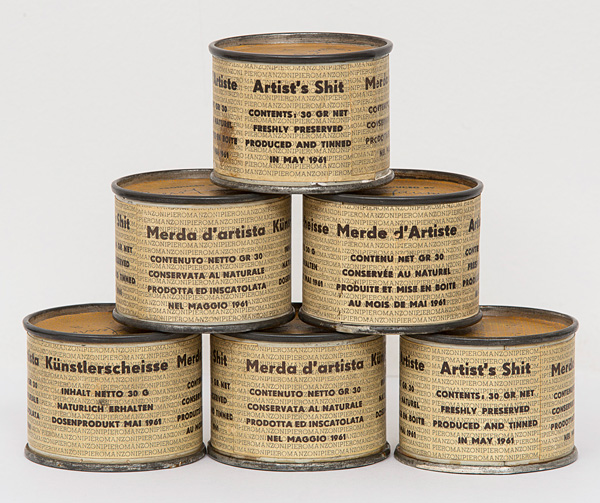
The Believer is pleased to present a series of excerpts from Jane Ursula Harris’ forthcoming book, After: The Role of the Copy in Modern and Contemporary Art. Harris’ survey assembles key examples of the copy from the onset of modernism to the present, and explores the copy’s relationship to the western canon.
When Egisto Manzoni told his son, “your work is shit”, he couldn’t have known the insult would inspire one of the most infamous works of Italian postwar art, Merda d’artista (Artist’s Shit), 1961. Consisting of 90 cans, each ostensibly filled with 30-grams of the artist’s own feces, “freshly preserved” and labeled as such, the artist’s response was particularly ironic given the fact that his father, an Italian count, ran a meat canning factory at the time.
If the work was a gesture worthy of Duchamp, like much of Manzoni’s work, it was also an act rooted in the alchemical. For in addition to literalizing his father’s taunt, Manzoni priced each can according to the market value of gold—around $1 a gram in 1961—effectively turning his shit into gold.
Merda d’artista shares similarities with an earlier series of Manzoni’s, Linee,1959, in which he drew lines on long scrolls of paper, ranging from 4 to 33 meters long, and rolled the paper into cardboard tubes. Each tube was given a price based on its length, and initially was intended to be opened and read by their owners like a book. Manzoni soon changed his mind, and decided the scrolls should remain hidden, shifting the work’s emphasis from a revelation of its contents to a speculation thereof.
“Although the Lines are hidden from view,” Manzoni writes, “their labels identify them as events that occurred at a particular time; they are like pieces of evidence bearing witness to the artist’s activity. The object of our gaze is therefore not a finished product, but rather the remnant of an act that has transpired.”
Manzoni’s play with fee structures, and his emphasis on the performative and conceptual, were reactions to the postwar consumerism of the 1950s, and the growing commodification of art. The economic boom that radically transformed Italy’s agrarian past into a cosmopolitan future particularly impacted Manzoni, whose family expected him to pursue law, and embrace his birth right as a member of the Italian ruling class. While Manzoni at first complied, he soon dropped out of law school to study philosophy, and then, with no formal training, began to make art.
 Piero-Manzoni, Achrome , 1958-59
Piero-Manzoni, Achrome , 1958-59
His postwar work was also a reaction to the hegemony of Abstract Expressionism. The latter’s Jungian explorations of the collective unconscious, and its existentialist leanings had equated subjective, spontaneous mark-making...
You have reached your article limit
Sign up for a digital subscription and continue reading all new issues, plus our entire archives, for just $1.50/month.
Already a subscriber? Sign in




